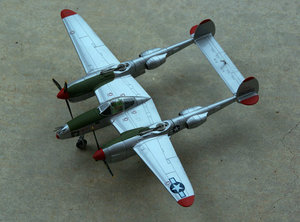Advertisement
Published: July 14th 2013

 DICK BONG
DICK BONG
The photo shows a diecast model in 48 scale of a P-38L that Dick flew during his second pacific tour. He did not have a great deal of confidence in his long range ability as an aerial gunner so he preferred to get in close enough that he could not miss before opening fire. He sometimes flew through fire and debris and once suffered an actual collision that was scored as a probable kill. During advanced pilot training in the AT-6 Texan Dick Bong was instructed and certified by Captain Barry Goldwater. Goldwater would eventually become a general in the Arizona Air Guard, a long time Arizona Senator and Presidential Candidate in the 1964 election.DICK BONG
America finally got things about right in a combat airplane when “Kelly” Johnson at what would later become the famed Skunk Works came up with the Lockheed P-38 Lightning. It was a goofy looking plane and it was unforgiving of any carelessness, incapacity, or neglect on the part of its pilot, but it was highly capable in many combat rolls. It was designed as a heavy fighter, but it could be used as a level bomber, a dive bomber, or a bomber escort. It was also excellent for ground support and for photo recon. The P-38 had a maximum speed of 414 mph, an operational ceiling of 40000 feet, and a range of 1300 miles. Twin Allison engines with counter-rotating props gave it a high rate of climb, and good high speed maneuverability. Armament consisted of four nacelle mounted 50 caliber machine guns and a 20mm cannon. The nacelle mounting was a stable gun platform that eliminated the need for convergence in concentrating its gunfire. Wing mounted guns would converge on a target at about 200 yards, but nacelle mounting was effective to a thousand yards. The Lightning was more effective in the Pacific Theater than it was in the European Theater because the Nazi fighters were capable of combat operation at 0.75 Mach, or three quarters the speed of sound, where the Lightning maxed out at 0.68 mach. It gave the Nazi pilots a decided advantage until the P-51 Mustang burst onto the scene. The Jap planes were plenty dangerous but they flew short of 0.68 mach. Lightning pilots enjoyed the same sort of performance superiority over the Jap pilots that the Nazi pilots briefly enjoyed over us. Still the Nazi pilots affectionately referred to the Lightning as the “Fork-Tailed Devil”, and to the Japs it became endeared as “Two Pranes, One Pirot”. The highest scoring American aces flew in the Pacific Theater. They were all Army Air Corps officers because the Navy turned its snooty nose up at a plane that could land on an aircraft carrier. Among the leading aces Dick Bong was the Big Dog with the Brass Collar. Dick arrived in Darwin, Australia assigned to 9
th Fighter Squadron (the Flying Knights), in the 49
th Fighter Group in September of 1942. They were P-38 pilots but had no planes because production priority went to the European Theater. Dick took temporary duty in P-39 Airacobras with the 39
th Fighter Squadron out of Port Moresby, New Guinea. On December 27 he scored his first aerial victories with them and was awarded a Silver Star. It was the same day that that the new P-38Gs were delivered to the 9
th. Dick took to air like a bat out of hell in them and quickly scored 27 victories. He was, promoted to major and pulled out of combat duty to become a combat tactics instructor at Foster Field in Texas, but he wasn’t done wreaking havoc on the Japs yet. He returned to the Pacific Theater in September of 1944 as an aerial gunnery instructor and volunteered for every combat mission that he could get flying out of Borneo and Leyte. He had tolled up 40 victories by December of 1944 at which point General MacArthur awarded him a Medal of Honor and sent him home again. He went on a bond tour, got married, and became a test pilot in a new jet fighter, the Lockheed P-80 Shooting Star. The plane had a manual fuel pump override that had to be engaged prior to takeoff. On August 6, 1945 that mechanism failed, the engine flamed out and he had to jump for it at low altitude. He hit the ground before his parachute could open and was killed. It was the same day we nuked the Japs.
Advertisement
Tot: 0.103s; Tpl: 0.009s; cc: 12; qc: 34; dbt: 0.0549s; 1; m:domysql w:travelblog (10.17.0.13); sld: 1;
; mem: 1mb

 DICK BONG
DICK BONG